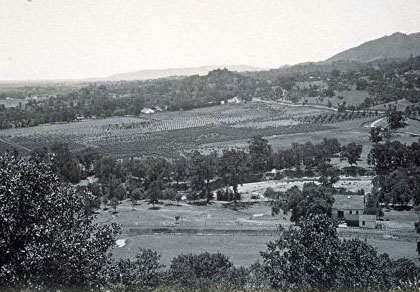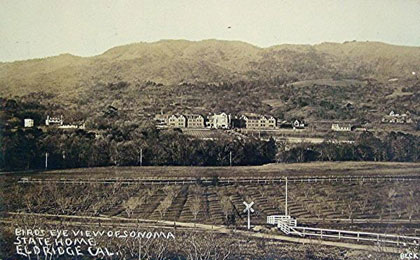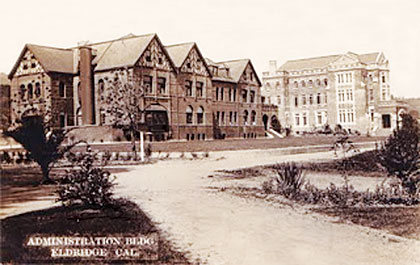Just wondering about… Early days of the Sonoma Developmental Center

Linda Blum | Sonoma Valley Sun
In July, 1919, a young woman by the name of Georgia Hazel Smith was brought to an institution where she was to spend the rest of her life. This was not an orphanage — she had a family. It was not a prison — she had done no wrong. No, it was the Home for the Care and Training of Feeble Minded Children.
On her Intake Form, her place of birth was written simply “ California”, as she became one of the eventual thousands of such lost and abandoned souls that would enter this place, to stay forever.
By this time, 1919, the home was no longer just for children, nor was it for the “feeble minded”. It had strayed far from its original charter, and would not circle back for many years.
However, back in 1883, when the first activists for the public care of the “mentally deficient” in California started their campaign, the mood was a belief in humanistic individuality. In other words, that every person had value. These campaigners were two prominent and wealthy women, Frances Bentley and Julia Judah of San Francisco, both of whom had a retarded child that needed care. The nearest such facility then was 2,000 miles away, in Iowa. So, with great zeal, they lobbied among the rich and powerful to establish an association to “provide and maintain a school and asylum for the feeble-minded, in which they may be trained to usefulness.” By 1884, they had accomplished their purpose, and the first home was funded.

Until 1891, several sites around the Bay were occupied – Vallejo, then Alameda, then Santa Clara as the resident population grew. Finally, in 1889, the State Legislature was persuaded to donate public funds, and a permanent site, in Glen Ellen, was selected. This 1,670-acre parcel was bought from ex-Senator William McPherson Hill for $51,000, approximately $1.5 million in today’s money.
The site was deemed ideal — generous water supply, mild climate, and suitable for crops and livestock, since the Home was intended to be self-provisioning. There would even be two railway lines directly to the station at Eldridge, named after one of the first commissioners to select the site, Capt. Oliver Eldridge.
An impressive ceremony accompanied the laying of the cornerstone on the new site in November, 1890. The Governor at the time, R.W. Waterman, spoke along with other politicians, although the Governor most instrumental in the initial activism was Leland Stanford, and his sister-in-law, Katherine Lathrop became the chairman of the Board of Trustees.
The next year, only the building that contained the Boy’s Wing, the laundry, the bakery, and kitchen were completed. Yet to come were the Girl’s Wing and the Administration Building, all in Gothic style. But it was time to move the 148 patients at Santa Clara onto the new, much improved site. The move was described in detail by then-Superintendent Dr. A.E. Osborne:
“The removal of the Home from Santa Clara to the present permanent site at Glen Ellen was successfully accomplished on November 24, 1891 … The long looked forward to and much discussed event was at last at hand. Throughout the Institution ran a thrill of peculiar excitement, a feeling of relief that the long struggle that had engendered so many bitter personalities and unfortunate prejudices was now behind us. As the children dressed they filed down from the dormitories, each with his or her bed-covers-rolled up to deposit them in given places ready for the trucks… As the train pulled away from Santa Clara our band could not refrain from playing “The Girl I Left Behind Me”… Arriving at the station, the task of unloading was quickly accomplished, and forming lines—the band leading—the procession marched up the new avenue to the enlivening strains of martial music. In front of Madrona Hall the procession halted, and as the band played “ Home Again” the different detachments were marched to their respective quarters, and in just one hour’s time our hungry patients were seated at the supper table, and the removal of the Home—a subject that for so long had held the attention of a large number of the people of the State, had invaded two Legislatures, and become the all absorbing topic of one of them; had touched the ermine of the Supreme Court, and had won its just cause, step by step, against innumerable odds-— was an accomplished fact. “
There also had been built a separate cottage for the care of epileptics, who at the time were also classified as “mentally deficient”. But the description of the new home sounds idyllic: “The epileptics occupy a pretty home, picturesquely situated some distance from the main building… At its feet is spread out the orchards and vineyards of the Home … To the right sweeps off, in graceful curves, the foothills, along which has been constructed a broad avenue leading to the main building… The site is a favorite one with our visitors, and truly excites the mind to loftiest thoughts. The air is ever mild, the sun is ever bright and warming. Thus, these unfortunates, against whom an unkind fate has hurled its most dire anathema, have received from the tender mercies of our State an almost ideal reclusiveness, where nature seldom frowns, and where all the elements are benign. “
Dr. Osborne was very much an advocate of helping the helpless, as he wrote in 1891: “The question of the utility of providing homes and asylums for the idiotic, the imbecilic, and the purely feeble-minded, has long since been settled and is no longer an issue. The demand of these classes to be recognized, cared for, educated, and trained, is practically no longer doubted or resisted.”
The terms in use at the time may seem shocking today, but the sentiment nevertheless is generous and charitable.
Although he, and his staff, seemed to be unusually compassionate, he did harbor ideas that were unusual. For one, his central tenet was that the “feeble-minded” would not benefit from academic teachings, but that they could learn, and feel useful by “doing”. To this end he “established in the California Institution our “auxiliary corps. This group of workers, selected from among our best trained children, are paid a monthly stipend varying in amount from 25 cents to $2. They wear a uniform, go about with considerable license, are given reasonable parole privileges, are treated as sub-officers of the Home, are publicly paid, and allowed to spend their earnings as they choose. Their presence affords a healthful moral stimulus to the others… It will be found much more desirable to officer our institutions in most, if not in all the subordinate positions, with trained patients rather than with the reckless, irresponsible paid help that it is our misfortune to so frequently have to deal with.”
Later experience proved him prescient, as more and more outside staff was hired in the years after 1900, and even in modern times, that proved to be “reckless, irresponsible paid help,” although the great majority of teachers and companions that staffed the ballooning facility have been ever devoted and caring.
From 148 young children in 1891, to a high of 4,000 residents of varying disabilities, not just mental, at its peak, the home has been an influential presence in California. It has gone through massive changes, just as society has changed.
First, it was a colony for helpless children who could not function in the outside world, but where the environment gave them the chance to keep busy with useful tasks: sewing, cooking, baking, farm work, mending shoes, doing laundry, etc.
But then, starting in the ‘teens, it devolved into what was never envisioned by the founders: a warehouse for undesirables. Now, there were delinquents and the physically maimed mixed together with the mentally maimed, in overwhelming numbers. The operation of the site began to be contracted to outsiders, and there was an emphasis on rigid rote learning, and discipline. Far from the original ideals.
Still, as the century progressed, so did the thinking about the care for the severely mentally disabled. Medical research leaped forward, and found new causes and cures, or medication that brought relief. And at the Sonoma State Home, the name after 1909, all this progress in therapies brought a brighter future for the residents.
In 1919, when the young, unfortunate Georgia Smith entered the home, her fate would be to live out her life in dull confinement, but was she or her fellow residents even aware of their surroundings? Read this account of a funeral at the home, and judge for yourself.
“The boy of 17, whose feeble mind has made a gulf between him and most boys of his age, had been for years an inmate of the institution for imbeciles and feeble-minded youth. Here he had received such training of hand and head and heart as his faculties were capable of. He had found kind care and a sunny home, and had been happy in proportion.

“The funeral services were held in the pretty chapel made bright and attractive by plants and flowers… We stood and watched the procession as it slowly returned to the building, shambling, unsteady, ill-formed, with odd-shaped heads and unillumined faces; and it seems a most pathetic sight. But it was not wholly a gloomy picture. Though the minds were darkened, and the human forms which should have been ‘forms divine’ were stunted and unattractive, the hearts were beating true. Though incapable of high mental advancement, though handicapped for life in every other direction, the capacity for loving was not extinct.”



